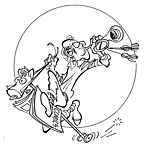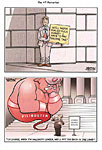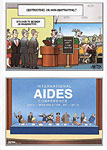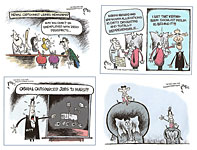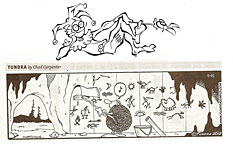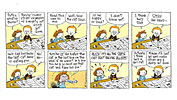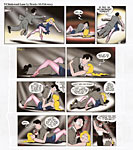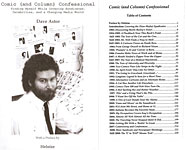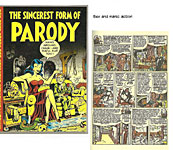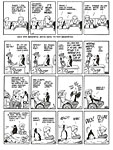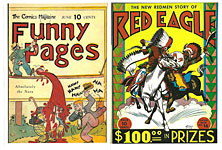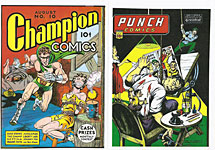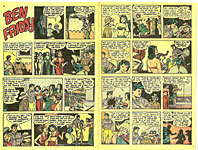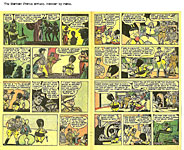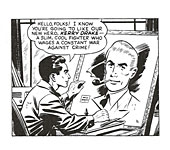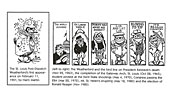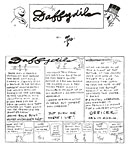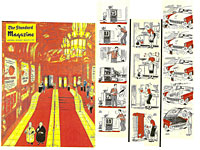 |
||||||
Opus 300 (September 30, 2012). Yup, here we are
at a Big ROUND Number. Three hundred—300!!! Or, as old Joseph Pulitzer might
say, “Threegoddamnhundred!” Right: this’s the three hundredth time we’ve met
here in the digital ether, at the rate of at least once or twice a month since
May 5, 1999. That’s13 years and 5 months, kimo sabe. Nope: with our customary perversity, we’re postponing the party for a couple of weeks. So if you were counting the days and expecting a Big Celebration hereabouts to mark The Occasion, you’ll be disappointed: here, you’ve just seen about all the fanfare you’ll see at the Three Hundredth posting. I’ve
never been able to conjure up the appropriately festive mile-marker for such
achievements in longevity. But maybe the accompanying self-caricatures will
serve to appease. We’re going to commemorate The Event in Harv’s Hindsight for the next couple of postings. First, in a little essay called “It’s Not My Fault,” we’ll explain how I wound up being a comics chronicler and critic—amply illustrated with drawings from my aborted career as a cartoonist. Next, in a piece entitled “Hubris and Chutzpah,” we’ll reveal the Secret Origins of the famed feud between Li’l Abner’s Al Capp and Joe Palooka’s Ham Fisher. Furtive eroticism and outraged innocence galore. You won’t want to miss it. You’ll have noticed over the last few months several postings in the Hindsight department that drag out for public ridicule various aspects of my own unlamented cartooning adventures—my efforts at magazine cartooning by mail, the history of my favorite unborn comic strip, Fiddlefoot, and my comic book creation, Zero Hero. You have yet to suffer through similar histories of my naval concoctions, Cumshaw and Beau Sandy. But do not gnash your teeth or pull out your hair in bitter disappointment: Cumshaw and Beau Sandy are coming. They’re just down the road a piece. A friend commented that these shameless self-indulgences show that I’ve become inordinately concerned about my legacy. Balderdash. Nothing inordinate about it: I’m old, and old people engage in self-adulations. Legacy? Well, maybe not: that’s too fancy a word for what we do here. Here, we merely blather on. And the shamelessness is the simple consequence of my discovering antique personal treasures in boxes downstairs. I thought once upon a time that these cartoons and comics were worthy of public perusal (not to mention $ale), and I still think so. (Why, being the conceited oaf that I am, would I change my so-called mind?) Hence, they’re being posted here at Rancid Raves just as I’d hoped they would be published in your local newspaper or in four-color fantasy pamphlets at your corner drugstore (which is where, in my home town of song and legend, we bought comic books before the arrival of comic book shops). I realize, despite the opening effusion about our meeting regularly here since May 1999, that you are probably among the millions who’ve not been regular $ubscribers since that distant time. But you might, nevertheless, want to know our plans for the next 300 postings. In a word—shorter. We hope to be shorter. As I’ve mentioned before in previous outings, I realize that almost no one wants to spend several mornings reading our latest colossal outpouring here at Rancid Raves, so I’ve taken a vow to be less windy. This posting is, we expect, a sample of the future. Shorter than erstwhile. But still crammed with nuggets of opinion and nifty artwork. Not so much news any more: there are other specialized websites where you can find more of that: Mark Evanier’s povonline.com, Alan Gardner’s DailyCartoonist.com, and Tom Spurgeon’s comicsreporter.com. And then there’s Mike Rhode’s ComicsDC blog, comicsdc.blogspot.com and Michael Cavna at voices.washingtonpost.com./comic-riffs. Here, we offer just the tip of the newsy iceberger. And the aforementioned nuggets. The main nuggets this time, f’instance, include a report on Zunar’s law suit in Malaysia where free speech loses although Zunar, thankfully, remains at liberty to create more mischief. We also review several recent and/or landmark tomes: forthcoming Bazooka Joe; The Sincerest Form of Parody; Bloom County, The Complete Library: Volume One, 1980-1982; Action! Mystery! Thrills! Comic Book Covers of the Golden Age; and The Collected Doug Wright: Canada’s Master Cartoonist. And we take a longer look at Allan Holtz’ Great Encyclopedia. Here’s what’s here, in order, by department:
NOUS R US Zunar Wins (and Free Speech Loses) in Malaysia Islamic Hooligans Run Rampant Again (But Not Without Cartoon Accompaniment) Liefeld Leaves DC and Gloats Waldo’s Bare Breast EDITOONERY R.J. Matson Laid Off Ditto Clay Jones
NEWSPAPER COMICS PAGE VIGIL Tundra Examined The Last Cul De Sac Porn at Chickweed Lane?
BOOK MARQUEE Bazooka Joe Forthcoming The Sincerest Form of Parody Bloom County, The Complete Library: Volume One, 1980-1982 Action! Mystery! Thrills! Comic Book Covers of the Golden Age
READING ALLAN HOLTZ’ GREAT ENCYCLOPEDIA A Somewhat More Extended Review Full of Lore and History
The Collected Doug Wright: Canada’s Master Cartoonist
Our Motto: It takes all kinds. Live and let live. Wear glasses if you need ’em. But it’s hard to live by this axiom in the Age of Tea Baggers, so we’ve added another motto:.
Seven days without comics makes one weak. (You can’t have too many mottos.)
And our customary reminder: don’t forget to activate the “Bathroom Button” by clicking on the “print friendly version” so you can print off a copy of just this installment for reading later, at your leisure while enthroned. Without further adieu, then, here we go—:
NOUS R US Some of All the News That Gives Us Fits
ZUNAR WINS BUT FREE SPEECH LOSES A Malaysian court has finally ruled in the lawsuit sought by cartoonist Zulkifli Anwar Ulhaque (aka Zunar) after being arrested under the country’s Sedition Act and Printing Presses and Public Act and having his cartoon book collections seized. Human Rights Watch reports that the court has ruled that the arrest was lawful. However the court ruled that the state’s continued holding of Zunar’s books and artwork was unlawful after the prosecutor opted not to file charges against the Zunar. The Court ordered their return as well as ordering the registrar of the court to determine any damages that should be awarded to Zunar. In a press release, the Human Rights Watch called the decision “a disturbing rejection of the right to freedom of expression in all its forms, including cartoons.” The press release continues: “Zunar has used political cartoons to highlight the responsibility of government officials for human rights abuses and other problems facing Malaysia. These include corruption, abuse of power, mismanagement of government revenues, racism, and failure to protect religious freedom.” Phil Robertson, deputy Asia director at at HRW said: “The court’s verdict against Zunar is no laughing matter, but of real consequence for Malaysia. The conclusion to be drawn is that politicians and officials who feel stung by Zunar’s pen apparently count for more than free expression.” Last year, Zunar filed a civil suit against the police and the government over his "unlawful detention” (reported in Opus 281, August 2011). The government controls Malaysia’s major newspapers and has forbidden the publication of Zunar’s work, so the cartoonist turned to alternative methods of reaching his readership: he published books and magazines of his cartoons and posted his work online. That, however, did not prevent further governmental attempts to silence him. His books and magazines were banned, his office and those of the enterprises that print his books and magazines were raided, copies were seized, and vendors were frequently warned not to sell his work. Said Zunar: "The cartoons mainly touch on issues that fail to be highlighted by local political cartoonists such as the prime minister (Najib Tun Razak) and his shop-a-holic wife (Rosmah Mansor), the conspiracy against (opposition leader) Anwar Ibrahim, Scorpene, racism, corruption and Malaysian politics in general.” To see some of Zunar’s work, re-visit Opus 281; look for “Spotlight on Zunar.” Zunar admitted that continuous government pressure had made it difficult for him to find willing printers and vendors to openly sell his book. Government officials have threatened legal action against printing presses and publishers associated with Zunar’s work, and against bookstores who stocked his books. In 2011, Zunar received the prestigious Hellman-Hammett award, given to writers and authors facing political persecution and violations of their rights to free expression. The Cartoonist Rights Network International also recognized the legitimacy of Zunar’s effort, giving him its Courage in Editorial Cartooning Award last year. Meanwhile, the Malaysian government has announced increasing censorship on cartoons by barring all cartoons for a period of two weeks before the general election, expected to be called later this year. Zunar and a group of political cartoonists announced their opposition to this violation of their rights and said they will defy the ban. Zunar released the following statement, which Tom Spurgeon published in his ComicsReporter blog: “I am extremely disappointed with the Malaysian High Court's ruling that my detention under the Sedition Act in September 2010 was according to the law. On the 24th of September 2010, I was arrested and jailed for two days just a few hours before the launching of my new comic book, Cartoon-O-Phobia. I then filed a suit to challenge the Malaysian government on the grounds that the arrest was made in bad faith, mala fide, and unlawful. But on the 31st of July 2012, the Kuala Lumpur High Court had held that the detention was lawful, based on the grounds that the police officers had reasonable grounds to suspect that the book was seditious. In the ruling, the high court clearly encourages police to use the power to detain anyone solely based on mere suspicion. This will help the Malaysian government to use more criminal laws to stop me from producing more cartoons that expose the corruptions by the Malaysian government. “The arrest was part of the modus operandi by the government to stop me from producing political cartoons unfavorable to them. Prior to that, they started by confiscating my books in bookstores, but I continued to draw. That prompted the authority to raid my office, raid the printers and threatening them. When all these still failed to stop me, they banned six of my books on the grounds that the contents are detrimental to public order. Finally, the detained me as a last resort. “The court has denied my fundamental right as a political cartoonist which contradicts the Malaysian Constitution that guarantees the freedom of expression to its citizen. Even though in the other part of the judgment the court had instructed the police to return all my books and drawing and pay the damages, this 'play-safe ruling' does not impress me. This ruling will not stop me, but will give me more strength to ‘Fight Through Cartoon.’ I will appeal to the higher court soon. And I will keep drawing until the last drop of my ink.” Spurgeon applauded: “As most of the wire stories have noted, Zunar received a favorable ruling on the confiscation of the books that came at the same time as the detention. I think the favorable ruling may have been a surprise, at least according to Zunar's own predictions in terms of whether he would see any satisfaction or not. That the cartoonist would pivot and hammer away at the remaining injustice rather than dwelling at all on the positive elements of the case is admirable to the extreme. Something that's intolerable is not made more tolerable by contextual circumstance. I also think he's right to place all of this in terms of a more extended campaign against the content of his political commentary—the fact that the cartoonist has had difficulty finding printing partners, for instance, isn't a legal outcome but extra-legal, something that's developed out of the general wave of government intrusion into this artist's life.” As for all of us here, gathered under the Rancid Raves banner, we also applaud Zunar and urge him on.
ISLAMIC HOOLIGANS AMOK ONCE AGAIN You may have noticed news reports of Unruly Muslims rampaging in the streets again, setting buildings afire and killing people. This time, it’s because a deranged man who has taken refuge in the U.S. made a movie in which the Prophet Mohammad is treated with cavalier disdain. Joining in the fun is the French satirical magazine, Charlie Hebdo, which prolongs its practice, inaugurated a year or so ago, of publishing cartoons depicting Mohammad. This time, Charlie published two editions, one "responsible" and one "irresponsible." Emma Heald at editorsweblog reports: “Last week's cartoons mocked the explosive reaction to the film ‘The Innocence of Muslims’ by parodying a popular French film, ‘Untouchables,’ and portrayed Mohammad in a series of poses, in one of which he is naked. In addition to the standard issue, this week's ‘responsible’ edition of Charlie Hebdo contains no pictures and very little text—the clear message being that to be ‘responsible’ is extremely limiting and does not actually mean doing real journalism. ... The paper contains only headlines and blank spaces. The ironic headlines include ‘Tunisia—all is well,’ ‘Morocco— all is well,’ ‘Egypt—all is well’ and ‘Libya—all is well,’ followed by ‘Mali— all is going very well.’ Others include ‘Prudence is the mother of safety’ and ‘Do you know how to plant cabbages?’” In an editorial, Charlie vows to “put no more 'oil on the fire,' nor will it 'blow on the embers,' and it will never again be 'irresponsible.' Charlie will never again comment on breaking news, will never try to make people laugh with subjects that might shock, will never forget that they must take into account ‘the susceptibility of the Benghazi Salafists’ and will subject its cartoons each week to a censorship committee overseen by the Union of Islamic Organisations in France, the Representative Council of Jewish Institutions of France and representatives of the pope. If Charlie Hebdo does this, the highly ironic editorial continues, nobody else will caricature contentious issues, and ‘everyone will be happy and the world will be more beautiful.’" In the "irresponsible" edition of Charlie Hebdo, whose offices were firebombed last year following its "Charia Hebdo" issue, features a cartoon on its cover depicting a caveman holding some oil and some fire, entitled "The invention of humour." The editorial in this issue calls for "The end of the fear of Islam," saying that the media and public figures promote excessive fear of Muslim extremists, and, for example, "Salafist" is used particularly to inspire fear. Meanwhile in Madrid, according to ANSAmed.info, “Spain's satirical weekly El Jueves published on its front page today a caricature of a number of possible portraits of the Prophet Mohammad. The cartoon depicts people 'suspected' of being the prophet with a banner reading 'But does anyone know what Mohammad looks like?'”—a perfectly logical question because, ostensibly, no representations of the Prophet are permitted by the religion he founded. (Actually, there are a few portraits—mostly by early Muslims. Besides, not all Muslims believe picturing the Prophet is blasphemous.) The Spanish cartoon “was published to express solidarity to French magazine Charlie Hebdo. Charlie published last week cartoons mocking the Prophet, an act slammed as blasphemous by those Muslims for whom depicting Mohammed is banned. Jose Luis Martin, a contributor of El Jueves and member of the newsroom's union, told Spain's Efe news agency that 'some won't like this, but we can't keep quiet. ... We cartoonists cannot censor ourselves every time there is the threat of a violent response.' “According to Martin, 'religious extremists from all confessions, Catholics, Muslims or Jews, are on one side, while on the other is freedom of expression.’ After the publication of the cartoon by El Jueves, Spain's embassy in Cairo has cautioned all Spanish nationals to take all necessary precautions.” At last—in France and Spain at least—a couple journalistically suitable responses to Islamic extremism. Elsewhere, Islamic Hooligans are preparing their protest against Charlie Hebdo and El Jueves: the agents of outrage have mustered great mobs of the insulted to hold their breath until they get their way. It worked when they were four years old, why not now? And, speaking of temper tantrums, we have—:
BAD BOY CHORTLES AND GRINS CHILDISHLY Rob Liefeld, the bad boy of comic books and a founder of Image, quit DC Comics in August, leaving a somewhat noxious odor behind him. He tweeted his departure, reported ICv2.com: "I walked off all 3 books," he twittered. "Can’t wait to see any attempts to spin. I have every email," he finished, ominously. His reasons for leaving, he said, were "the same as everyone’s you hear," adding: "I had at least 20 editorial battles and won 80%, but those battles wear you down." It sounded like it had been coming for a while: "This is the 4th time I quit in the last 4 months. This time it will stick." Liefeld, whose specialty, judging from his artwork, is drawing anatomy without backgrounds, “had begun with DC’s New 52 relaunch on Hawk and Dove until it was canceled, and more recently was writing and penciling Deathstroke, and plotting The Savage Hawkman and Grifter. His runs will end with the zero issues, he said.” His departure, saith ICv2.com, “kicked off a twitterstorm about his ‘editorial battles.’” Then a month later, Liefeld, who still looks like the teenager he behaves like, heard that his former editor and foe Brian Smith was also bidding DC farewell. Said Smith: "Last day at DC this Friday! Good times, learned a LOT (good and bad). Back to freelance and creator owned comics for me." Liefeld smacked his lips and chortled gleefully: "So I walked out of DC due to my editor’s incompetence. Now he’s gone. #funny." I’m not sure this episode reveals the good side of Liefeld.
WHEREFOR WALDO. Waldo, the spectacled, pom-pom hatted youth in a red-and-white striped shirt, has been hiding out from dedicated readers for 25 years, and an anniversary volume is out from Candlestick Press. Waldo’s British creator, Martin Handford, sold his creation in 2007, as unsullied as ever. But Waldo got in trouble once, according to Susan Carpenter of the Los Angeles Times: “The original 1987 book made the American Library Association’s list of most challenged books for one of its images—a topless sunbather’s bare breast was exposed in a beach scene crowded with hundreds of other beachgoers.” Ahhh, those self-righteous puritans: eagle-eyed as ever, they can spot a naked boob in any panorama of covered ones, no matter how vast. What would we do without them? Probably rot away in miserable decadence.
READ AND RELISH In Albuquerque last summer, we visited the Indian Pueblo Cultural Center and, after looking at hundreds of beautiful pots lined up in display cases, learned about the Pueblo Rebellion of 1680, which was news to me, not being a student of the area’s history. Directed by the charismatic Po’Pay of the Ohkay Owingeh Pueblo, some 25 pueblos rose up and drove off their Spanish overlords, killing twenty-one of the province’s forty Franciscans and another 380 Spaniards. The survivors abandoned the “colonies” and fled to Mexico. The Spanish returned a decade or so later but had to negotiate terms with the pueblos, who wanted, most of all, to be allowed to worship in their traditional ways; they’d been forced to convert to Christianity by enthusiastic Franciscans, and that was one of the chief causes of the 1680 revolt. The Hopis (I think I have this right) believe humans emerged from the earth, and after Emergence comes Continuance, the gradual southern movement of the peoples. And so hoary oral history confirms a theory often resisted by other native American tribes that probably the American continents were populated by peoples who crossed from Asia via the Bearing Strait land bridge and then drifted South.
EDITOONERY Casualties of the Summer AT THE END OF JULY LAST SUMMER, the St. Louis Post-Dispatch laid off 23 staffers from the newsroom, advertising and production—including R.J. Matson, the paper’s staff editorial cartoonist. The Post-Dispatch is the largest in the Lee Enterprises chain, which owns 53 daily newspapers and 300 weeklies, shoppers and specialty publications mostly, plus online sites, in 23 cities. Founded by A.W. Lee in the 1890s, Lee acquired Pultizer, Inc., owner of the Post-Dispatch, in 2005, in a deal now seen by many as the purchase that saddled the property-gobbling company with debt that forced it into bankruptcy last year. The reductions in staff continue a chain-wide budget-balancing purge. While cutting costs by dropping staff, Lee gave CEO Mary Junck a stock bonus worth some $655,000 last winter. Junck’s previous employment includes being publisher and president of the Baltimore Sun (which laid off its legendary staff editoonist, KAL, a few years ago) and the St. Paul Pioneer Press (which laid off the esteemed Kirk Anderson several years back). When Lee merged the Lincoln Journal with the Lincoln Star in 1995 to create what was then the chain’s second-largest daily, the paper’s staff political cartoonist, Paul Fell, was laid off. (He now self-syndicates his work, which, with additional editorial comment by the perspicacious Shawn Peirce, is available by free subscription at PaulFellCartoons.com.) It’s a track record that makes me fear for the continued livelihood of the Lee-owned Arizona Star’s superlative editoonist, David Fitzsimmons, whose cartoons we’ve featured here almost every time we discuss the current crop of visual comedic mayhem. Junck’s bonus is a reward, perhaps, for her negotiating a deal last year with Lee’s lenders to refinance $759.5 million of its distressed loans and forestall collapse. Lee employees are understandably outraged by the news of layoffs at the papers Junck is responsible for. In Montana last winter, missoulanews.bigskypress.com reported that one former staffer described Junck as “no strategist,” saying, “You could have thrown water balloons in the newsroom and hit ten better candidates for CEO.” ... Another said Junck and other managers “crossed the line from managing to looting a long time ago.” United Media Guild, which represents St. Louis area workers, pulled no punches in its assessment of Junck’s work: “Junck and [CFO Carl Schmidt, who got a $250,000 bonus] are the fiscal geniuses ... [responsible] for eliminating promised health insurance to its retirees, forcing current employees to take unpaid furloughs, freezing pensions, and cutting pay” while laying off hundreds of employees across the country. Paul Friswold at Dailyrft.com put it this way: “If I may be so bold as to ask, what the hell kind of business strategy do you call giving the boss a big bonus and then giving staff their pink slips? Is this trickle-down economics at work, or merely simple plundering?” No one has heard any post-employment comment from Matson, who continues to cartoon for Roll Call; he gave no interviews that I’m aware of (although his September 20 cartoon depicting the “47 Percenter” might have an alternative message).
Matson has cartooned for Roll Call since 1986, the year after he graduated from Columbia University. At the same time, he was art director for the Washington Monthly (until 1988) and then cartooned for the New York Observer (1989-2010) and the Post-Dispatch, which he joined in July 2005.
AND THAT’S NOT ALL. On August 17, Clay Jones announced that he’s been laid-off from his staff cartooning job at the Free Lance-Star in Fredericksburg, Virginia. At Daryl Cagle’s blog, Jones recounted some of the glories of his stint at the Free Lance-Star: “I’ve enjoyed the camaraderie of the newsroom, election night pizza, breaking news, racing to the newsroom at midnight on a Sunday to cover the death of Osama bin Laden, receiving angry phone calls from readers, physical threats from a fireman, and that exasperated look on my editor’s face every time I showed him a cartoon he didn’t like.” Jones told Cagle that he doesn’t know what he’ll do next, “although he does mention he’ll still be drawing two cartoons a week for the Free Lance-Star, and will continue drawing for syndication” with Cagle cartoons. Said Jones: “I do know my career as a staff cartoonist, something I spent seven years fighting for before it finally happened, is over. I do have other skills and I’m going to try to figure out what those are. There’s gotta be an opportunity for a professional smart ass somewhere out there.” To
which report, Cagle later added this: “UPDATE—After his editor killed his final
cartoon and asked him to draw a new one as he walked out the door, Clay has decided
not to freelance two cartoons a week for the Free
Lance-Star. Interestingly, the killed cartoon [which is posted here] is
live on the Free Lance-Star’s web site.” Clay Jones, who calls himself "an unreliable conservative" and believes it is his daily goal to lampoon authority and make it look as ridiculous as possible, joined the Free Lance-Star in 1998 after having spent 7-8 years bouncing around from the Panolian in Missouri to the Daily Leader in Brookhaven to self-syndication. "My cartoons do not tell readers what they should believe. I hope they simply challenge people to think." With the Matson and Jones job losses, the number of full-time staff editorial cartoonists in the nation’s newspapers sinks to 58 (or, possibly, 63: there are five on the list that Cullum Rogers began in May 2008 about whose fate I’m in doubt).
PERSIFLAGE AND FURBELOWS “Experience is the worst teacher: it always gives the test first and the instruction afterward.”—Benjamin Franklin A short lesson in democracy. In a democratic form of government we must assume that the governing body includes people of varying opinions about everything. It is a foregone conclusion that such a government cannot function unless all those in it agree to compromise. A government that achieves governing without compromise is perforce not a democracy: it’s a dictatorship. Those who will not compromise are therefore sabotaging the government and are guilty of treason. Seems a fairly straight-forward piece of logical reasoning to me.—RCH
NEWSPAPER COMICS PAGE VIGIL The Bump and Grind of Daily Stripping CHAD
CARPENTER is one of the great success stories of newspaper comic strips. With
the help of a dedicated friend, he’s managed to self-syndicate to hundreds of
newspapers, spreading the Alaskan wilderness far and wide. Animals. Frozen
landscape. Carpenter is talented and canny. And who could ask for more? Here is
a strip that could have been done differently (which we examine not to ridicule
or denigrate but to exemplify the ways in which this delightful medium works). Most of Carpenter’s Tundra strips are single panel enterprises, like this one. But here, I think he gave away the punchline too soon. Imagine, for example, if the wall-papering guy were moved to the far right in this strip. Your comprehending eye would start at the left and move slowly to the right along a cave wall decorated with prehistoric glyphs until, finally—at the last moment—surprise! You’d come upon the wall paperer. Ha! Those glyphs are not paintings on the cave wall: they’re wall papered. Ha! Boffo. Joke. Big laughs. But in the version we have before us, the wall paperer appears so early in the left-to-right progression that the joke is over before you get to the remainder of the wall-papered wall. No surprise. Still funny, but it could have been funnier if Carpenter had positioned the wall paperer further to the right, making strategic use of the elongated shape of the panel to create the surprise that is at the core of the joke.
THE LAST CUL DE SAC
At his
blog, Richard Thompson, Parkinson’s stricken creator of the beloved but
too-short-lived strip, wrote about the last release (published September 23),
as follows: The last Cul de Sac was drawn in November of 2007. No it wasn't, it was drawn about ten months earlier for the Washington Post Magazine. The image above is that original watercolor and, as I've said before, it was instantly my favorite, because "it's got drama, comedy and meta-ness, and it makes a point that's self-deprecating enough to be self-loathing." I traced the watercolor in ink and did an overlay with colors indicated by numbers so it could be used for the syndicated version. That's the Sunday Cul de Sac that appeared in about 70 papers on November 25, 2007 and that's the strip that Tom Spurgeon saw before he wrote a brief, meticulous and very kind review. I'd originally planned to draw a new Sunday Cul de Sac for September 23. After umpty-ump weeks of reruns it'd be a relief to the readers and I had a good idea for a finale. Mom is reading to Alice. The story ends "And they lived happily ever after." Alice reacts badly to this bit of fairy tale boilerplate. She goes off on a rant about what a boring, vague and unsatisfying way to end an exciting story that is and why do writers do that? It's like they run out of ideas or something. Alice ends up in Petey's room, of course. And in the final panel something funny happens. But try as I might I couldn't get it drawn. The lines wouldn't behave and the words wandered. So I emailed my editor, the unflappable Shena Wolf, admitted defeat, and requested the above strip. Shena made sure it hadn't already been used as a repeat then headed off for two weeks in Yellowstone to rassle bears. Her number two, the equally steady-nerved Gillian Titus, handled the actual substitution. I still like this strip a lot. It's simple, built on misunderstanding and confusion, and it shows Alice and Petey at their best. I wouldn't take Petey's curtain line too seriously. He is a bit of a pessimist, after all.
***** Incidentally, you can obtain a signed copy of Thompson’s first book, Richard’s Poor Almanac, a rare compilation of his earlier Washington Post feature, which is available in limited quantity. Visit his blog, richardspooralmanac.blogspot.com, for pricing and contact information. Maybe. Eventually. I visited, and didn’t find any such information. Maybe later. Try again. Don’t give up.
PORN IN THE FUNNIES ONE
OF THE ODDER MOMENTS in this odd year of political hypocrisy occurred in Los
Angeles, otherwise home to sexually saturated movie biz, where a few
puritanical readers professed outrage at the September 1-7 sequence in Brooke
McEldowney’s 9 Chickweed Lane as it appeared in the Los Angeles
Times. In the strip, a sensitive and compassionately comedic creation
often about romance and love, Amos, Edda’s paramour, has been trying to muster
the nerve to propose marriage to her for weeks. Finally, he works up the
gumption at the end of August and goes to the theater where she’s dancing. Now
emboldened with implacable resolve rigidly focused, Amos clambers up onto the
stage at the finale of Edda’s performance, but, clumsy as always, he trips and
sprawls across her as we see here in Saturday’s strip. “Inappropriate for a comic strip that children could be reading!” proclaimed one irrate reader, who has yet to explain how the perpetually innocent children would recognize the position depicted as the “missionary position” in sexual intercourse. Another shocked reader called the strips “porn” and worried about her granddaughter seeing such filth—again without explaining how her precocious granddaughter would know filth when she saw it (having been kept innocent all these years by her diligent grandmother). At the Times’ reader representative journal, Assistant Managing Editor Alice Short, who oversees the features sections including the Comics page, said she didn't think the strip meant to be racy: "I'm not sure how this current story line will end, but it started a couple of weeks ago," Short said. "It's pretty clear that the musician wants to propose to the ballerina. I see it as a story about love, and I don't believe anything untoward was intended." Oh, yeah? Short is being a little disingenuous. McEldowney clearly intends that adult readers see the picture as approximating a copulating couple (and when Amos refers to something in his pocket, he’s echoing that classic Mae West line: “Is that a banana in your pocket or are you glad to see me”—or words to that effect). John Glynn, vice president and editorial director of Universal Uclick, which distributes the strip, said the syndicate had received no other complaints. Only in proximity to Hollywood does fantasy sex offend. Gosh. Who’d’ve thought?
Quotes and Mots Longtime syndicated columnist Donald Kaul is retiring after having a heart attack. Among his last published words are these: “I’ve covered fools, crooks, and charlatans over this half century. But for the most part, they had some sense of seriousness about them—an appreciation for the national interest as they saw it. ... The current bunch of miscreants is nothing like that. Centrist Democrats, who talk a good game but don’t do much about it, are battling increasingly radical Republicans, a fierce tribe of Bible-thumping know-nothings fueled by money from modern Robber Barons who want to sell the country off by the board foot and metric ton for their personal profit. Thus, we approximate the times described by the Irish poet W.B. Yeats: ‘The best lack all conviction, while the worst are full of passionate intensity.’ Does that describe Congress or what?” “Life does not cease to be funny when people die any more than it ceases to be serious when people laugh.”—George Bernard Shaw
BOOK MARQUEE Previews and Proclamations of Coming Attractions This department works like a visit to the bookstore. When you browse in a bookstore, you don’t critique books. You don’t even read books: you pick up one, riffle its pages, and stop here and there to look at whatever has momentarily attracted your eye. You may read the first page or glance through the table of contents. All of that is what we do here, starting with—:
Work In Progress Abrams ComicArts is bringing out an omnibus Bazooka Joe book next spring. Here’s what editor Charles Kochman says about it in a press release: “It will have four bonus comic strips in it. What I love about this book (and it's true of all of Abrams' books), is that the content determines the format, so we're going to turn the book on its side and we're going to stain the sides pink so that they look like a giant piece of bubblegum. We have original art, showing the strips side by side; lots of foreign strips; classic strips; and some advertising. “The other thing I'm really excited about for this book is the background on Wesley Morse, who created the material. He did the poster for the Copacabana, he did the Cotton Club art, he did the Folies Bergere posters, and is also famous for doing the Tijuana Bibles. We'll include (obviously some of the tamer) Tijuana Bible stuff. It's a crossover title; kids are going to read it. “We talk about the secret of Bazooka Joe's eye patch—there was a Hathaway shirt ad at the time [and the man modeling the shirt wore a piratical eye patch], and it was the height of fashion and it made him look debonair. So Wesley thought, ‘Let's give Bazooka Joe an eye patch.’ He's got a photograph of his son (who's contributing an intro to the book) with a baseball cap when he was a kid. We'll have those photographs in the book and show the history. Jay Lynch is writing a piece for it; Bhob Stewart, who did a piece for Blab a long time ago that was the history of the strip, has revised and expanded that and we’re going to reprint it. I'm really excited about the Bazooka Joe book.” We did a biography of Bazooka Joe some years back—in Opus 127, in case you want an advance look at some of which the Abrams book will include. Yeh, we’re excited about it, too.
INDUSTRY LORE AND OTHER HISTORICAL NEWS Former Editor
& Publisher senior editor and syndication industry reporter David
Astor has produced a collection of humorous essays about his 25 years of
reporting on comics and cartoonists, Comic (and Column) Confessional (238 6x9-inch pages), from Xenos Press.
The Sincerest Form of Parody Edited by John Benson; Introduction bv Jay Lynch 192 7x10-inch pages, color; Fantagraphics paperback, $24.99 WITHIN A SHORT YEAR of Mad’s debut as a comic book in the fall of 1952, imitations were flooding the newsstand, proclaiming the resounding success of Harvey Kurtzman’s satirical funnybook with the usual form of sincerity in a capitalistic economy—and this, despite Mad’s not turning a profit until perhaps as late as its sixth issue, John Benson tells us in his extensive Notes at the end of the book. Undoubtedly, it was the quality of the product that inspired imitation: readers learned of this new astonishingly funny and subversive comic book by word of mouth; comic book cartoonists, editors and publishers—one eye always on the newsstand competition—saw Mad and loved it. And wanted to do one of their own. And so they did. In
this book, Benson has collected samples from nine of the 13 imitations—Panic (EC Comics own Mad imitation), Whack, Eh!, Riot, Get Lost, Nuts,
Madhouse, Flip, and Unsane (the others, Crazy, Wild, Super
Funnies, Bughouse). The craziness that Mad inspired is on flagrant
display here—venal businessmen, greedy merchants, unscrupulous personages so
numerous as to suggest nothing wholesome existed anywhere in American life;
unforgettably, ordinary women are made ugly and attractive women are portrayed
as blatant sex objects, bulging out of their skin-tight attire. Greed, sex,
cheating, lying—all of the American dream on exhibit. And whenever there is
movement, it is exaggerated movement—Tex Avery style. Action and brick-bat
comedy bursting from every panel and frenzied page. I remember picking up a few of these titles in the wake of reading the first issues of Mad; and I was disappointed because the imitators seemed to have grasped only the most apparent of the devices of Mad satire. And then they worked them mercilessly, beating them to a standstill—pale imitations, mostly. But some were successful—usually in the quality of the artwork rather than in the skill of the satire. And much of this rambunctiousness, hits and misses, is on view herein. Benson’s Notes at the end are a too-brief history of the Mad copycat industry. The man who annotated much of Russ Cochran’s EC Comics Library supplies here a digest of the results of his research into Mad and parody—insightful, tantalizing, often surprisingly detailed.
Bloom County, The Complete Library: Volume One, 1980-1982 By Berkeley Breathed 288 8.5x11-inch landscape pages, b/w and Sunday color; 2011 IDW hardback, $39.99 I’VE RESISTED GETTING started buying this Library. How many “complete” runs of how many comic strips does one need in one lifetime? Well, after perusing a copy of this at the local library, I’ve decided I need to buy at least one more—this volume anyhow. I’d forgotten how funny Bloom County is, and it was highly pleasurable to be reminded in these pages. The volume begins with a short Introduction by Breathed, a few of his collegiate The Academia Waltz strips, in which Bloom County takes shape, and then starting with the release for December 8, 1980, the first two years of the strip, three to a page, each page meticulously dated. The big bonus, however, can be found in the marginal notations by Breathed—explaining topical references and philosophical underpinnings. The
undeniable Opus (the penguin, remember?—who took over the strip) shows up on
January 18, 1982, just as the strip launches into its second full year. He’s
the front seat of a car with Brinkley and Brinkley’s father, who opines:
“Brinkley, And Opus was a whole lot cuter then. Smaller beak. Much better.
Action! Mystery! Trills! Comic Book Covers of the Golden Age, 1933-1945 Edited by Greg Sadowski; Foreword by Ty Templeton 208 8x10.5-inch pages, color; 2011 Fantgraphics paperback, $29.99 THIS SELECTION of 176 funnybook covers from the medium’s most flamboyant period tells us visually more convincingly than anything else we’re likely to read what that Golden Age was like. Action, thrills, funny animals and scantily clad bathing beauties galore are on display. Even Templeton, who begins by arguing that the “golden age” is idiosyncratic—peculiar to everyone’s twelfth year—finally, after considering the work of such artists as Alex Schomburg, Jack Cole, Reed Crandall, Joe Simon, Jack Kirby, Charles Biro, Will Eisner, Lou Fine, Walt Kelly, Mac Raboy, Sheldon Mayer, Joe Shuster, Bill Everett, L.B. Cole, Ed Ashe and others, agrees that the age was golden after all. Apart from the sheer pyrotechnical riot of color and composition and anatomy, the book’s footnotes by Sadowski are virtually a thumbnail history of the Golden Age. For each book cover, he supplies issue number, date, and name of artist—plus a short paragraph about the artist or the publisher. For instance: the first cover in our visual aid, upper left, is by Sheldon Mayer, drawn for the first title of a publishing enterprise formed by William Cook and John Mahon after they left Malcolm Wheeler-Nicholson’s National Allied in 1936; the title was The Comics Magazine, but the subtitle, Funny Pages, soon elbowed the less exciting denomination off the cover. Going clockwise, our next cover displays the work ofJimmy Thompson, “the first notable African-American artist/writer in comic books,” says Sadowski. “His Indian tales were well researched, sensitively written, ad displayed a high level of draftsmanship.” He was best known for his 1940s Robotman for DC. Next is a Jack Kirby cover—vibrant action, radiant sex appeal. And finally, the punchline for this review—Gus Ricca’s portrait of cover artists such as he, at the end of his rope for a cover idea.
Quotes and Mots The most annoying thing about old age is the loss of memory. Not only that, but the loss of memory.—Sign Somewhere Barely a month ago, Newsweek ranked my alma mater, the illustrious U. of Colorado at Boulder, Number Three in the Top Ten party schools of the nation. Then along comes Playboy, clearly the sine qua non in such matters, and Hef downgraded CU, dropping it off of his website’s own Top Ten list altogether; last year, it was Playboy’s Number One. On what basis was this disastrous defection accomplished? Sex, probably. The same Playboy list scored the Colorado School of Mines “worst” on its “sex life” list. (Probably mining engineers don’t have a sex life. Just rocks and minerals.) We conclude that for Playboy, partying means copulating. Drinking and smoking pot and otherwise carrying on in a shocking but risible manner apparently counts for naught.
BOOK REVIEWS Critiques & Crotchets
READING ALLAN HOLTZ’ GREAT ENCYCLOPEDIA I DID NOT EXPECT TO SPEND any great amount of time reading Allan Holtz’s American Newspaper Comics: An Encyclopedic Reference Guide after having spot-checked some of it for our review in Opus 296. It’s the sort of book you consult; you don’t read. But lately I have been doing just that, browsing bemusedly through it—turning pages, reading an entry here and an entry there, then, having spied a familiar name, jumping around to trace its various appearances. I stopped at Bunky, Billy DeBeck’s Sunday topper for Barney Google, and warmed to see its alternate title, Parlor, Bedroom and Sink, and then wished there’d been something there about the diminutive Bunky’s fate at the hands of Fagan “the Viper,” that high-handed hobo and champion scalawag who embodied evil itself (in a comical melodramatic way, of course). Useless Eustace stopped me cold just now. What a great name. It was a weekly strip, it sez here, running 1941-1946. Why no month and day? Holtz explains in the entry: “The strip was sold in batches, so strips were often printed out of order and reprinted as long as the newspaper cared to use them. The highest numbered strip I’ve found is no.272, giving a weekly newspaper a supply of over 5 years worth of strips. Because of this, I’m assigning an end year of 1946 but the strip was definitely used later (sometimes decades later) by papers.” Drawn by Horace T. Elmo and self-syndicated. But I was on the way to check Texas Slim, which I’d seen the other day and wondered where Dirty Dalton was. Ferd Johnson’s strip comedically pairing a good guy and a disreputable one has always intrigued me. But here, entry no. 6176, was the Texas Slim title all by itself. Oh—reading down the column, another Texas Slim, also by Johnson: the first ran 1931-1932, the second, 1940-1958. All true: the strip was killed early on but enjoyed a comeback in the 1950s. Ah—next down the column, here’s Texas Slim and Dirty Dalton, the initial run, 1925-1928 with Holtz’s note: “Dirty Dalton often gets dropped from the title.” Here’s Inbad the Sailor! Wally Wallgren’s pre-World War I strip in one of the Philadelphia papers. I knew the title but could only guess at the dates. Holtz says January 1 - June 18, 1911. (For the complete story of Wally, see Harv’s Hindsight for February 2009.) And here’s Barney Baxter, Frank Miller’s intricately hachured strip about an aviator and his bumpkin-looking but actually canny sidekick, Gopher Gus. Ran September 30, 1935 - January 22, 1950, but the credits are a mare’s nest: Miller did it for seven years, then Bob Naylor (comics’ great pinch-hitter) for six-month stretches, then Miller again. I have a vague recollection that Miller had health problems (eyesight?) that caused him to abandon his creation from time to time. The strip ceased after he died in 1949, Holtz says. Started in the Rocky Mountain News where it ran until December 5, 1936, when it was picked up for syndication by King Features. Jack Spranger caught my eye, reminding me of Ben Friday, the strip reprinted in Famous Funnies that so enthralled me as a teenager.
So I went looking for Ben Friday. No luck. Then I consulted the Cross-Title Reference at the end of the book, and there it was—finally entitled Bantam Prince. And I remember when the diminutive Prince arrived in the strip (depicted in our visual aid), turbaned and grinning and capturing the heart of Ben Friday and all his luscious girlfriends. At the Bantam Prince entry, I see that the strip (which ran May 2, 1948 - February 28, 1954) started as Bodyguard, then Ben Friday, and finished as Bantam Prince when the little king charmed everyone and knocked the stalwart Ben Friday off the marquee. What started me on this page-flipping safari was not sheer nostalgia. I was assembling dates for a piece I did on Chic Young for the online Comics Journal (tcj.com), and when I came to Young’s penultimate creation, Dumb Dora, I found a confusion of start dates. Comics historian Brian Walker in his The Comics: The Complete Collection, the monumental 2011 amalgamation of two of his earlier histories, The Comics Since 1945 and The Comics Before 1945 (published in 2002 and 2004 respectively), says the strip started January 30, 1924; another source said January 25. Holtz asserts the latter, but I finally settled on Walker’s January 30 because it was a Monday in 1924; the 25th was a Wednesday and most comic strips are introduced on Mondays, not Wednesdays. That’s true today, and I suppose it might’ve been different in 1924 but I tend to think not. (Oddly, Holtz doesn’t list among his sources Walker’s The Comics, the most accurate and successful attempt at a comprehensive history of American newspaper strips around.) Right about this time, Walker phoned. He’d just received his copy of Holtz’s book and wanted to compare notes. He said he was also impressed with the volume of research the book contains and how indispensable it will be to future cartoon historians. One of the first entries he looked at was the one for his father's creation, Beetle Bailey. Since he knows the history of that strip intimately, he was surprised to see Mark Brewer credited as doing the inks from 2001 to the present. Said Walker: “Mark Brewer never worked on Beetle.” And Greg Walker is still inking the strip; he didn’t stop in 2003. Mort is credited as the artist on the strip from Sept. 4, 1950 to April 13, 2003 but, in fact, he is still doing the pencils. And Jerry Dumas is listed as a writer from 1955 to 1995, but is still part of the gag-writing team. The entries for other Comicana strips, such as Hi and Lois and Sam's Strip, contained similar errors of omission and/or misrepresentation. Walker also noted that the entry on Doonesbury perpetuates the canard that Garry Trudeau’s strip is ghosted by Don Carlton. Not so. Carlton is not a ghost: he’s the strip’s inker. And Walker should know: he produced an entire tome devoted to Doonesbury and the Art of Garry Trudeau in the conviction that Trudeau “had not received adequate recognition for his talents as an artist and graphic designer.” The book ably provides that recognition. Trudeau’s relationship with Carlton began in late 1971, Walker notes. A year after Doonesbury debuted on October 1970, Trudeau had entered graduate school in graphic design and found that classes and workshops “were intense and often lasted from eight in the morning until midnight,” Walker writes, “leaving him little time to work on the strip.” So he asked Universal Press, his syndicate, for help, and he was introduced to Carlton. Soon after, they began the routine that has prevailed for over 40 years: Trudeau pencils the strip, usually in weekly batches, which he sends to Carlton, who then inks Trudeau’s pencils and sends the finished product to the syndicate for distribution. Until 1990, Trudeau systematically destroyed his penciled strips, but when Newsweek reporter Jonathan Alter learned of it, he convinced Trudeau that these were the “originals,” highly prized by comics aficionados and students of the artform, and that he ought to keep them. Trudeau agreed, at first reluctantly, and Walker’s book makes use of the cartoonist’s inventory of pencil originals, publishing many of them, some side-by-side with Carlton’s inked version. There can be no doubt that Doonesbury is Trudeau’s artwork, not Carlton’s. Learning of such miscues prompted me to inspect other entries more diligently than my cursory thumbing through for a quick ans short review had permitted. And, alas, I found other errors. In my review in Opus 296, I loudly trumpeted Holtz’s accuracy, proclaiming, “You’d have to prove him wrong, and it wouldn’t be easy.” Well, you can’t do it unless you know for sure something contrary. And, given the scope of the book—the thousands of entries, each a possible forcing bed for half-a-dozen or more factual missteps—the occasional error is more likely than not. But, as I said, Holtz would have to be proven wrong. So I wandered off to entries about the strips I know best, the ones whose creators I’ve written most extensively about, having relied, usually, upon testimony from the principal himself. At Terry and the Pirates, Holtz lists several assistants during Milton Caniff’s tenure, some of which I question. Caniff’s studio-mate Noel Sickles has long been acknowledged as helping on the strip in the early years (backgrounds, Caniff told me; and Sickles’ chiaroscuro technique was adopted outright by Caniff), but Alfred Andriola was more secretary than artist in the Caniff studio; in his own accounts of his time with Caniff, Andriola never claimed to have drawn anything. And Caniff never mentioned either Charles Raab or Lloyd Ostendorf (Sigma Chi fraternity brothers) as assisting on Terry. Raab would assist Andriola on Charlie Chan but didn’t work on Terry. Neither did Ray Bailey, whom Holtz also credits as an assistant in the 1940s. Caniff employed Bailey as an assistant during the World War II years to help with various art chores (inking insignia designs, specialty drawings and the like) but never on Terry. Admittedly, Caniff could be protecting his reputation: Terry is his most highly regarded creation, and he understandably wanted to be remembered as the sole creator. And Caniff’s been known to tinker with the narrative legend about Terry. He always credited syndicate head Joseph Patterson with the young-kid-and-his-adult-guardian concept for Terry and Pat Ryan, but Caniff had concocted exactly that arrangement in his previous strip, Dickie Dare, when Dickie started following Dan Flynn around; at the same time, Caniff always claimed he’d invented the Dragon Lady out of whole cloth, but it was Patterson who suggested that he bring a lady pirate into the strip. Giving Patterson credit for the kid-guardian concept was perhaps Caniff’s unconscious way of making up to Patterson for denying him credit for the Dragon Lady. So maybe Andriola and Raab did help out with pen and ink. But these names are coupled to Terry by Holtz’s resident “ghost expert,” Alberto Becattini, and Becattini is demonstrably wrong on occasion, as we shall see anon. Caniff was not as jealous about soloing on Steve Canyon, so when I read that entry and encountered a host of assistants and ghosts, most of the names were familiar to me, but Holtz’s source for this information, Steve Rowe, seems to have missed altogether Richard Rockwell’s single-handed stint on the strip. Rockwell began assisting Caniff in 1953, and eventually, he penciled the strip for Caniff’s inks. (Caniff believed, correctly I think, that someone else inking the strip would not approximate his style well enough, thereby betraying the ghosting; so Caniff gave up penciling and did the inks himself, preserving his distinctive touch. And if he didn’t like a Rockwell-penciled panel, he’d just change it.) But neither Rowe nor Holtz remembers, apparently, that Rockwell drew and wrote the final months of the strip, April through May, after Caniff died. Rockwell is correctly credited for the last daily, June 4, 1988, but he didn’t do the last Sunday, June 5; that was Bill Mauldin’s work. Caniff worked on an Associated Press panel cartoon, Mister Gilfeather, which is listed here as Colonel Gilfeather. Mister Gilfeather is cited as an alternate title. Yes and no. The feature was created in 1930 by Thomas A. “TAD” Dorgan’s younger brother Dick as Colonel Gilfeather, an outright knock-off of Gene Ahern’s Major Hoople, the blowhard protagonist of Our Boarding House. When Al Capp took over the panel in1932, he couldn’t abide the pontificating Colonel and conjured up instead the Colonel’s younger brother, who was slightly less pontifical. The name change reflected this change of focus. When Caniff inherited the cartoon, he stayed with Mister Gilfeather until he could no longer stand it, then asked to change the feature altogether: leaving the Gilfeathers in the lurch, Caniff took off in the direction of such human interest features as Out Our Way, re-titling the cartoon Gay Thirties. The change took place on May 4, 1933, not, as Holtz has it, May 12. The May 4 release appears in my biography of Caniff, Meanwhile: A Biography of Milton Caniff, Creator of Terry and the Pirates and Steve Canyon. Mentioning Andriola reminds me of the legendary inauguration of his detective strip, Kerry Drake. Andriola started with Charlie Chan in 1938 but was soon bored with the cerebral machinations of its title character and introduced a younger, more action-prone sidekick for Chan named Kirk Barrow. But Barrow wasn’t enough to sustain Andriola’s interest; the strip ceased May 30, 1942, and Andriola moved to Publishers Syndicate which promised him a strip of his own if he’d do Dan Dunn, Publishers’ imitation Dick Tracy, until its contract ended on October 3, 1943. When Dunn’s time ran out, Andriola brought Kirk Barrow back under another name and made him the title character in his new strip, Kerry Drake. The
legend is that Andriola started his new strip by simply converting Dan Dunn to Kerry Drake, introducing his new leading man—and the new strip—in one of
the last installments of the old strip, a clever maneuver that gave his new
strip a roster of subscribing newspapers immediately. In the second panel of
the Dan Dunn release for October 1, 1943, Andriola drew himself at the
drawing board, putting the finishing touches on a portrait of his new detective
hero. Many of the nits Walker and I are picking involve the names of assistants and/or ghosts. I’m not sure the book is much improved by the presence of this information—particularly when so much of it is sheer guesswork, however insightful the guesser. Holtz realizes the pitfall, saying in his Introduction that he rarely engages in the practice himself, “as I’ve been proven wrong too many times.” Despite his wariness, Holtz gives ghost names, relying for the information upon others who he apparently thinks are good at spotting the identities of unnamed artists. Even so, he urges “the reader to be skeptical.” And sometimes Holtz voices his own skepticism in an entry. At Our Boarding House, for example, he says, after listing a number of artists and writers: “Every reference has conflicting information—creator information here is shaky but as close as I can figure it.” And after saying Cap Stubbs and Tippie started in 1918, Holtz adds: “Strip may have started earlier (some references claim as early as 1916).” In most instances, Holtz diligently cites the sources of his information, a nearly fail-safe fall-back practice: if the reader knows another source that he/she regards as more reliable, he/she can discount the Holtz source. At times, the distinction Holtz makes between an assistant and a ghost seems to blur. Assistants “help” on a strip—inking, lettering, and so on; a ghost usually does the whole thing, pretending to be the credited creator but without getting any credit. But “ghost” seems a fairly elastic term. At the Dennis the Menace entry, Becattini lists a number of “ghost writers.” I recognize the name of at least one with whom I worked years ago: he is a gag writer. He wrote gags for single panel cartoons, and he contributed regularly to my store of gags. Ditto to Dennis’ creator, Hank Ketcham. So is a gag writer a “ghost writer”? Technically speaking, I suppose he/she is. But “gag writer” is more accurate, I think, for single-panel cartoons; “ghost writer” implies concocting plots and spinning out storylines (even if they are just setup sequences leading to punchlines). And
sometimes the artifact under inspection doesn’t fit into any of the handy
cartooning categories. At the St. Louis Post-Dispatch, the weather for
the day is announced on the front page with a diminutive cartoon bird making a
comical remark, usually alluding to both the weather and a current event. Holtz
calls this feature, Weatherbird, a “daily panel, Sunday strip.” This is
the same nomenclature he applies to Dennis the Menace, but despite Weatherbird’s longevity (it started February 11, 1901, and is the longest-running American
daily cartoon), I wouldn’t call it a “daily cartoon panel” even though,
strictly speaking, that’s what it is. Holtz also says the Post-Dispatch is Weatherbird’s syndicate, but I suspect that the term “syndicate” is a residual term from the spread sheet blanks Holtz employed to catalog his findings. For most of the feature’s life, I think distribution to other newspapers would be unlikely: it’s concocted daily by the cartoonist and editors in the newsroom, who engage in a competition to create the comedy. Dan Martin is the current artist (yes, it’s still going!), and when I asked him about it, he said it wasn’t syndicated any more although it might have been a century ago: “Around 1912, then-Weatherbird artist S. Carlise Martin teamed with Jean Knott to produce a full page Jinx and the Weatherbird Family comic [probably the Sunday strip Holtz refers to], that, to my understanding, enjoyed some limited syndication [for a short time]. The paper registered the image with the U.S. Patent Office in 1932, and Lee Enterprises [the current owner of the Post-Dispatch]has renewed it.” (You can find the history of the Weatherbird in Harv’s Hindsight for October 2003.) Similar
imprecision crops up at Daffydills, a feature by TAD. Holtz calls it an
“illustrated prose column,” but “column” implies a column of type, and while Daffydils is mostly verbiage, it’s not a column of type. As we can see in the
adjoining visual aid, it’s a 2-3 panel cartoon, almost all words, all
hand-lettered in the manner of a comic strip, and decorated with tiny stick
figures. I’d call it a “a 2-3 panel cartoon of hand-lettered verbal anecdotes.”
Lengthy, I realize, but perhaps more accurate. Again, resorting to critiquing the entries about comics that I know well, here’s Gordo, Gus Arriola’s great strip (the subject of my biography of Arriola, Accidental Ambassador Gordo), Holtz has all the start and end dates correct; the strip had more than one each because the daily ceased while Arriola was in the service during World War II, but he did a Sunday Gordo for the duration and then resumed the daily in June 1946 after the war. And Holtz also lists those who worked on the strip: Lee Hooper lettered and inked for a time 1946-48, and in 1958 when Arriola was laid up with lower back spasms, Gordo was produced by several of his cartoonist friends around his home in Carmel—Eldon Dedini, Hank Ketcham, Al Wiseman (Ketcham’s assistant), and, even, commercial illustrator Al Parker (although I’m not sure about him), all of whom Holtz names. But enough. It’s easy to find fault with a work as massive as this. The book is flawed, but it is also a stupendous achievement, and the blemishes are usually minor (if sometimes annoyingly misleading). Moreover, Holtz has warned us that we should be skeptical about some aspects of his entries. In the final analysis, if we were to count every scrap of data, we’d doubtless find more accurate than inaccurate information. As Walker told me, “Whatever its flaws, I have to have the book.” Me, too; and it’s now back on the shelf where I can pull it out quickly whenever I need to consult it to verify information—or find some. Incidently, for delving into the history of our beloved medium, you can go further than Holtz’s book: at his website, strippersguide.blogspot.com, Holtz regularly posts rare findings from his forays into the vast reaches of newspaper microfilm files hither and yon.
The Collected Doug Wright: Canada’s Master Cartoonist Edited by Seth and Brad MacKay 240 11x14-inch pages, color as well as b/w; Drawn & Quarterly 2009 hardcover, $39.95 THE GIGANTIC DIMENSION of this book is determined by the format of the weekly comic strip that first brought fame to Wright. Entitled Nipper, it was published always in vertical format. Its protagonist was a bald-headed but otherwise normal kid of about five, who managed, by simply being a normal kid—albeit in pantomime—to create havoc wherever he went, usually accompanied by his parents. Nipper started in March 1949, a year before Hank Ketcham’s five-ana-half-year-old menace started south of the 49th parallel. The coincidence of time is merely coincidence, however: both are clearly independently arrived at creations. Well over half the book—163 of its 240 pages—reprints Nipper at the generous rate of two strips per page, each strip dated, with occasional marginal notes by the editors. That brings us to December 1962, and there is probably more Nipper: a second volume is promised, covering 1963 to 1981, wherein, I assume, Nipper will morph into Doug Wright’s Family, ruled over by Nipper and his equally bald younger brother. I knew nothing about Wright when I encountered the title of this tome in a catalog recently, so, naturally, I had to get a copy to find out who he was. Born in Dover, England in 1917, Wright made a living as staff artist for a British appliance manufacturer, illustrating newsletters and sales bulletins. Bored with that, he immigrated to Canada in 1938 when he heard the country’s largest insurance company, Sun Life, was looking for illustrators. When World War II commenced in Europe, Wright joined the Royal Canadian Air Force and spent the ensuing years drawing comics for various military publications, using the pen name Ozzie (a corruption of his middle name, Austin, or “Aussie,” as his mother called him). Returning to civilian life, Wright, still on the staff at Sun Life, tried to crack the U.S. freelance magazine cartoon game, failed, returned to Canada and began freelancing cartoons to the Montreal Standard, which, in June 1948, offered him a gig doing a weekly comic strip called Juniper Junction, when its creator, Jimmy Frise, died. Nipper was concocted the following winter, although, at the time, Wright thought the first strip was a simple one-shot; encouraged by Standard editors, he did some more and became famous. Later, after marrying in 1952 to a woman 12 years younger, he started, in 1954, doing a weekly cartoon on current events. The
book includes a few Juniper Junction cartoons—drawn in a hayey manner
quite different from the stark simplicity of Nipper—but none of Wright’s
last creations (they may be too topical for reprinting now, a half-century
after their initial publication; although the next Wright volume may show us a
few). MacKay supplies a biographical essay, which is amply illustrated with
sketches and incidental artwork (for the Standard’s weekly magazine,
Wright did impressively detailed covers, drawing in a style that reminds me of Carl
Rose) and family photographs. Oddly, Nipper was named by the Standard
editors, choosing a submission in a reader contest, but Wright, like another
cartoonist, Charles Schulz (who hated the name “Peanuts”), didn’t like
the name he was subsequently to live the rest of his life with. Another of Canada’s master cartoonists, Lynn Johnston, supplies an Introduction. After reporting her early engagement with Wright’s work, thanks to her father, who doted on it, she credits Wright with teaching her the fundamentals of her craft: “What he taught me was to think of the art as a performance. Pay attention to detail. Take the time to research everything from body language to backgrounds. See things from all of the characters’ points of view. Don’t overdo a gag, let the audience participate and get it for themselves. Be believable. Use your skills to do the best you can do at all times! Be consistent and be humble. Without humility, creativity like this cannot happen.” The book is designed by Canadian cartoonist Seth (Gregory Gallant), who imbues it with his distinctive clean and spacious aura, sometimes devoting a whole massive page (even a two-page spread occasionally) to displaying a single bald-headed Nipper frolicking across the expanse. It is Seth whose fascination with Wright’s work has resulted in this rescue of the cartoonist from complete and utter obscurity. Seth rehearses his 20-year search for the cartoonist’s works, culminating in his discovering, after years of pawing through heaps of newspapers stacked in garages, that the Wright family had donated virtually a complete run of Wright to the National Archives. Seth enlisted journalist MacKay to help assemble the Wright record and a subsequent project in which they hope to perform similar rescues of other forgotten Canadian cartoonists. Pondering the works of Wright, Seth realized that Wright and his contemporaries “deserve credit for their role in the shaping of our modern Canadian identity. ... These artists, who worked mostly in the middle of the 20th century, had an instrumental role in taking the moldy old 19th century images of Canada and making them modern. They recast all those Mounties and trappers and habitants into contemporary (for that era) streamlined icons. It’s the kind of thing, done in plain sight, that no one thinks to notice. The Canadian pop culture images that we know so well today were largely reshaped in those times. ... You can almost chart Canada’s transformation from the rural to the urban in a flow chart from Jimmie Frise to Doug Wright.”
Read and Relish “Children are our hope, and they are reflective of life’s longing for itself.”
To find out about Harv's books, click here. |
||||||

send e-mail to R.C. Harvey Art of the Comic Book - Art of the Funnies - Accidental Ambassador Gordo - reviews - order form - Harv's Hindsights - main page |
